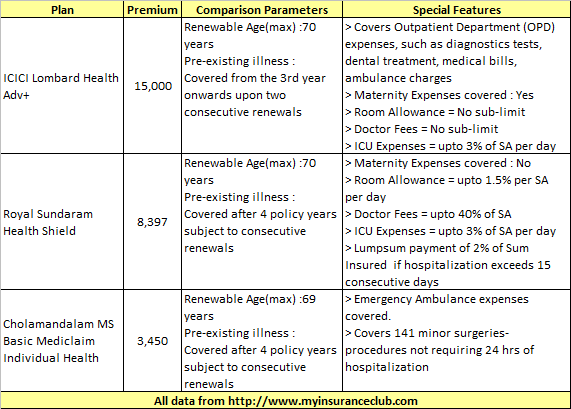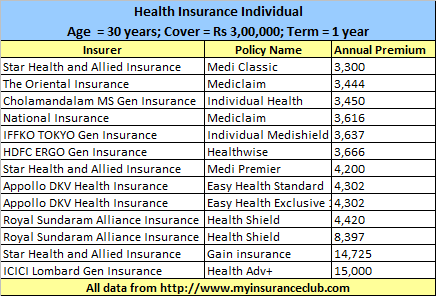Today we discuss two concepts in Health Insurance, generally present in the policy document, which policyholders are not normally aware about, because they don’t care to look at those clauses. We are talking about concept of Loading and Co-Pay . Let’s talk about both the concepts one by one.

What is Loading in Health Insurance ?
Loading, in terms of Mediclaim Insurance means the Insurer (Company) will charge more amount than the regular premium from the policy holder after a claim has been made. Suppose, for eg., you have an Insurance policy and you pay Rs 8,000 each year in premium, and now suppose in 3rd year you make a claim, then from the 4th year onwards, your premium increases by a certain amount which can range from 5% to even 300%. The increase depends on the company terms and the rules. If the loading is 50%, your premium will increase by 50%, which is Rs 12,000. Loading can apply with every claim you make. Please check the brochure off loading is 50% , your permium will increase by 50% , which is Rs 12,000. Loading can apply with every claim you make.
Please check the broucher of ICICI Lombard mediclaim policy stating different slabs for different amounts of claim made. One more product, I would strictly advice all the readers to stay away from, is Star Health’s Red Carpet policy for Senior citizens. This is one of the most fictitious policy, I have ever come to known. Not only is this policy, making an option of Co-pay up to 30% but also has Loading as well. So, a senior citizen, who is normally retired and must also be suffering from one ailment or the other, will be forced to shell out a huge amount of expenses for hospitalization in addition to the premium paid. According to me, it is of prime importance, for the prospective client to look for the clause of Loading in the policy document of said company.
But it doesn’t mean that all Mediclaim Policies in the market come with the Loading clause. There are a few companies in the market without such Hidden Riders like United India(Gold and Platinum only) and Max Bupa. This concept of Loading defeats the very purpose of Mediclaim. An individual takes a Mediclaim Policy, just so that he won’t pay anything extra, out of pocket but ultimately, he is spends more by way of Loading after the claim has been made..
Why Loading concept is there from Insurance Companies ?
Generally, the insurance company is of the view, that once a policyholder has made a claim due to any illness or some major illness, he might make the claim again in future (if not near then in the distant future), so just to be prepared to face those recurring claims, the company tries to safeguard itself, by procuring a larger premium by way of Loading. Sometimes, it make sense but most times, it does not! The only justification on the company’s part, is that they make this loading thing clear, at the very inception of the policy, in its brochure as well as its policy documents and they do take, a declaration from client that they knows about it with his/her signatures. If the client doesn’t read/go through these details and is later on required to shell out more from his pocket, then it is his mistake not the company’s.
So my advice for all the readers out there; Dear friends, don’t get fleeced! By the sheer laziness of not reading/going through the policy brochure or documents, we will be facing heavy Loading, both of money and of tension.
Is loading acceptable ?
On the brighter side, companies can not just have any kind of unreasonable loading in policies. These have been challenged by consumers, and often the consumer forums have taken decisions in favor of consumers. Here’s a case in point –
Amina Sheikh, an octogenarian, was insured for Rs 1.5 lakh for a decade by the National Insurance Co. Ltd. under its Mediclaim Policy. When her policy was due for renewal in 2007, the company increased the premium from Rs 5,305 to Rs 32,787. This was done to make it financially unviable to continue with the policy. Her daughter protested, so the premium was brought down to Rs 23,845, which too was very high. She was forced to pay this premium and renew the policy to avoid a break in insurance. Her daughter wrote to the company demanding an explanation for the arbitrary increase. The divisional manager replied that the policy now stood cancelled as Amina did not seem happy with the firm. He also clarified that the premium doubles immediately when a person crosses 80 years of age and for her, the premium had been loaded by another 100% in anticipation of claims arising due to advanced age.
CWA then filed a consumer complaint. Rendering the judgment on behalf of the bench, the forum president observed: “Managers of public sector undertakings are duty-bound to take decisions based on facts and not in an arbitrary and irresponsible manner based on their emotions.”
The Forum held that the loading of the premium was arbitrary, unjustified, and contradicted the terms of the policy, which is deficiency in service and unfair trade practice. The forum directed the firm to continue the policy by charging Rs 13,112 and to refund the excess premium collected. It also directed the company to continue renewals without loading as long as the insured paid regular premium in time. Also, compensation of Rs 15,000 for mental agony and Rs 2,500 as costs were granted. Source : TOI
[DDET Click to Read 2 more cases]
Case Study 2: In Dr Rupali Shirke’s case, the insurance company loaded her premium by 50%, increasing it from Rs 7,727 to Rs 11,824 and decreased the sum insured from Rs 5 lakh to Rs 2.5 lakh. This was done because of two claims lodged by her, which were genuine and settled by the company. This was considered as an “adverse claims ratio” by the firm. When she protested, the insurance firm ignored it.
CWA filed a complaint challenging loading of premium and reduction of the sum insured by United India Insurance Co. Ltd. The Forum held that the firm was bound to renew the policy on the same terms and conditions. It directed the firm to restore the sum insured and charge regular premium without loading. A compensation of Rs 5,000 and costs of Rs 5,000 were also awarded.
Case Study 3: In the case of Hoshang Khan, after a claim was lodged, the insurance firm imposed a loading of 400%, increasing the premium from Rs 10,558 to Rs 55,952. Khan could not afford the high premium, so he sent the premium cheque without the loading, but the insurance company returned it. CWA filed a complaint against United India Insurance Co. Ltd. The Forum held that loading of premium was arbitrary and unjustified. It directed the company to accept the premium without loading. On receipt of the basic premium, the firm was directed renew the policy with retrospective effect from 2006 onwards to maintain the policy’s continuity.
[/DDET]
What is Co-Pay in Health Insurance Policies ?
Co-pay, as the name signifies is the payment made by two parties, even if that is not in equal proportions This is another important factor to be kept in mind while selecting the Mediclaim policy for oneself. Under this clause, the insured is also required to bear a certain percentage of expenses incurred on illness/disease while hospitalized, either conditionally or under certain conditions..
Usually, in our country, the concept of Co-Pay only comes into picture after a certain age. Most of the companies levy this clause once the policyholder enters the Senior citizen category, that is after the age of 60. Mostly this percentage is mentioned as 20% pay – i.e., policyholder is required to pay 20% of the expenses out of his own pocket. For eg, if Mr X, who is 63 years old falls sick and has to be admitted to the hospital for 5 days, for which hospital bills come out to be Rs 80,000 and his Mediclaim Policy mentions 20% co-pay, then Mr X has to pay Rs 16,000 and rest Rs 64,000 will be borne by the company. The basic understanding behind this clause, is that the company is expecting an increase in claims from this particular section of the policyholders, – the senior citizens. The company’s thinking is that as the age progresses, the chances of policyholders getting sick increases. The expenses on his treatment for a given complication will also be higher as compared to the same treatment for someone who is much younger, say age 38 or 40. Looking at it from the prospective of the company, this clause seems logical but as an individual policyholder, I believe this is one of the main thorns in the flesh of the policyholder who is entering the age bracket of 60s. I believe this percentage has to go down, or associated to some very major complications/illnesses, or senior citizens should given some rebate on premium year on year just to balance out this Co-Pay clause.
Some other companies, preferably PSUs, charge this co-pay clause if the policyholder is taking treatment in out of network hospitals. Earlier, they would apply this co-pay concept, in case the policyholder chooses a higher-end hospital with air-conditioned services or someone from smaller city getting treatment in costly cities like Delhi, Mumbai, Chandigarh, Bangalore etc. At that time, co-pay clause was built in to ensure that the policyholder choose the appropriate hospital/doctor/room level relevant to his economical status as well as the premium paid by him to ensure there is no overspend just because of the existence of the mediclaim policy.
So dear all, please keep an eye for co-pay clause in the policy which you are thinking of buying for yourself as later on, it may negate the very concept of cashless or reimbursement later on as later on! And in the 60s when people have mostly retired with no real source of income, to pay even 20% of the total expenses out of own pocket would be a considerably big amount.
So should you choose a company without co-pay and Loading clause ?
No, not always , you should not make co-pay and other clause as the sole criteria for choosing the policy because even if a company does not have co-pay and loading clauses today , it can include them at later stage . As per Medimanage company
“Again in our opinion, a clear loading policy is better than those policies where there is no explicit loading clause. This is because every policy wording has a term where it clearly mentions that “all terms including premium are subject to change on renewal, based on claims or otherwise.” – this makes you exposed to an unlimited extent, when you grow older. Bajaj Allianz implemented a new loading clause in August 2010. The most scientific loading policy is that of ICICI Lombard, which has classified claims into Chronic and Non Chronic. Non-chronic claims like an accident or Malaria etc. would have a loading only above a certain threshold claim amount, which is not carried forward in the subsequent year. Whereas chronic ailments will have a loading of 75% and carried forward upto 200%.
Finally remember, even if you are buying a policy without loading this year, nothing stops the Insurance Company to add a loading clause at the time of renewal. Dont choose a company only because it does not have loading, choose a company which is stable in its services, and does not make frequent and big changes in their policy conditions.”
Please let me know your comments on this topic . Do you feel its ethical to just mention in the document and not make customers aware about it from their own side ? Do you think if companies disclose about it while selling the product face to face, it would create more respect for companies ?
The inputs are provided by Dhawal Sharma, who is an agent for Kotak and Max Bupa .






